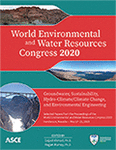World Environmental and Water Resources Congress 2020
Urban Water Management and Mitigation Analysis in Response to Hydro-Climate Change and Regional Subsidence
Publication: World Environmental and Water Resources Congress 2020: Groundwater, Sustainability, Hydro-Climate/Climate Change, and Environmental Engineering
ABSTRACT
More cities in the United States are identifying urban flooding as a frequent, destructive, and costly natural hazard affecting property, roadway, and other infrastructure while causing significant economic disruption, and negative consequences to human health and safety. In addition to rainfall during major hurricane and tropical storm events, coastal cities like New Orleans and Houston are vulnerable against high intensity short-duration rainfall events. Located below sea level and subjected to regional ground subsidence, New Orleans relies on their pumps and canals to handle one inch of rain the first hour, half-an-inch every hour thereafter. Aging and poorly maintained infrastructure systems can increase the amount of storm runoff to an already strained drainage system, creating pockets of flooding in ill-equipped and vulnerable neighborhoods. Using existing elevation certificates, BFE, regional subsidence rate, and inundation statistics from recent flooding events, this paper evaluates effects of subsidence on property elevation and long-term repetitive loss potential of the structures. An estimated yearly ground subsidence rate of 9 mm/year increased flooding potential from 30% to 42% for the properties evaluated.
Get full access to this article
View all available purchase options and get full access to this chapter.
REFERENCES
American Society of Civil Engineers (2017) Infrastructure Report Card https://www.infrastructurereportcard.org/
Boesch, D. F., M. N. Josselyn, A. J. Mehta, J. T. Morris, W. K. Nuttle, C. A. Simenstad, and D. J. P. Swift. (1994). “Scientific assessment of coastal wetland loss, restoration and management.” Journal of Coastal Research Special Issue No. 20.
Couvillion, B.R., J.A. Barras, G.D. Steyer, W. Sleavin, M. Fischer, H. Beck, N. Trahan, B. Griffin, and D. Heckman (2011) “Land area change in coastal Louisiana from 1932 to 2010”, U.S. Geological Survey Scientific Investigations Map 3164, scale 1:265,000.
Environmental Protection Agency (2019) “Storm water management model” https://www.epa.gov/water-research/storm-water-management-model-swmm
Erbe, V., Frehman, T., Geiger, W.F., Krebs, P., Londong, J., K.-H. Rosenwinkel and Seggelke, K. (2002) “Integrated modelling as an analytical and optimisation tool for urban watershed management” Water Science and Technology Vol 46 No 6–7 pp 141–150
FEMA. September 2015. Reducing Flood Risk to Residential Buildings that Cannot Be Elevated. FEMA P-1037 https://www.fema. gov/media-library-data/1443014398612-a4dfc0f86711bc72434b8 2c4b100a677/revFEMA_HMA_Grants_4pg_2015_508.pdf; USACE. National Nonstructural Committee (NNC). https://www.usace.army.mil/Missions/Civil-Works/Project-Planning/nfpc/.
FEMA (2019). “Protecting your property from flooding.”
Gironas, J., Roesner, L.A., Davis, J. (2009) “Stormwater management model application manual,” EPA/600/R-09/000
Harriet, F. (2013). “The Prevalence and Cost of Urban Flooding - A Case Study of Cook County, IL.” Center for Neighborhood Technology, May 2013.
Kearney, M. S., J. C. A. Riter, and R. E. Turner (2011) “Freshwater river diversions for marsh restoration in Louisiana: Twenty-six years of changing vegetative cover and marsh area” Geophys. Res. Lett., 38, L16405.
Kovacs, P., Guilbault, S. and Sandink, D. (2014) “Cities Adapt To Extreme Rainfall: Celebrating Local Leadership.” Institute for Catastrophic Loss Reduction, Toronto.
Louisiana 2017 Coastal Master Plan (http://www.coastalmasterplan.louisiana.gov/)
Matthias Mengel, Anders Levermann, Katja Frieler, Alexander Robinson, Ben Marzeion, and Ricarda Winkelmann (2016) “Future sea level rise constrained by observations and long-term commitment.” PNAS March 8, 2016. 113(10) 2597-2602.
Mumford, L. (1956), “The Natural History of Urbanization,” in E. L. Thomas Jr., ed., Man’s Role in Changing the Face of the Earth (Chicago: University of Chicago Press, 1956), 386, 397.
NASA (2018) “Urban Flood Monitoring Using Remote Sensing Observations.” https://arset.gsfc.nasa.gov/sites/default/files/disasters/urban-flood-18/urban-floodweek2.pdf
National Research Council (2013) “Levees and the National Flood Insurance Program: Improving Policies and Practices.” Washington: National Academy Press.
National Research Council (2009) “Urban Stormwater Management in the United States.” Washington: National Academy Press.
National Weather Service’s Hydrologic Information Center – Flood Loss Data. www.nws.noaa.gov/hic
Platt, R.H. (2006) “Urban Watershed Management sustainability, one stream at a time” Environment. Volume 48, Number 4, pages 26–42.
Singh, V.P. and Frevert, D.K. (2010) “Watershed Models,” Publisher: CRC
Snowden, J.O., Ward, W.C., Studlick, J.R.J. (1980) “Geology of Greater New Orleans: its relationship to land subsidence and flooding,” Publisher: The New Orleans Geological Society, Inc.
Templeton, R.C., Vivoni, E.R., Méndez-Barroso, L.A., Pierini, N.A., Anderson, C.A., Rango, A., Laliberte, A.S., and Scott, R.L. (2014) “High-resolution characterization of a semiarid watershed: Implications on evapotranspiration estimates,” Journal of Hydrology 509 (2014) 306–319
USACE (2007) Hurricane and Storm Damage Risk Reduction System manual
USACE (2006) Depth-Damage Relationships for Structures, Contents, and Vehicles and Content-To-Structure Value Ratios (CSVR) in Support of the Donaldsonville to the Gulf, Louisiana, Feasibility Study Final Report, March 7, 2006, Contract No. DACW29-00-D-0001, Delivery Order No. 0038, G.E.C. Project No. 22316638.
University of Maryland College Park and Texas A&M University (2018) “The growing threat of urban flooding: A national challenge.”
World Bank (2019) www.worldbank.org
Yuill, B., Lavoie, D., and Reed, D. J. (2009) “Understanding Subsidence Processes in Coastal Louisiana,” J. Coastal Research, Special Issue, No. 54, 23-36
Information & Authors
Information
Published In
World Environmental and Water Resources Congress 2020: Groundwater, Sustainability, Hydro-Climate/Climate Change, and Environmental Engineering
Pages: 258 - 268
Editors: Sajjad Ahmad, Ph.D., and Regan Murray, Ph.D.
ISBN (Online): 978-0-7844-8296-4
Copyright
© 2020 American Society of Civil Engineers.
History
Published online: May 14, 2020
Published in print: May 14, 2020
Authors
Metrics & Citations
Metrics
Citations
Download citation
If you have the appropriate software installed, you can download article citation data to the citation manager of your choice. Simply select your manager software from the list below and click Download.
